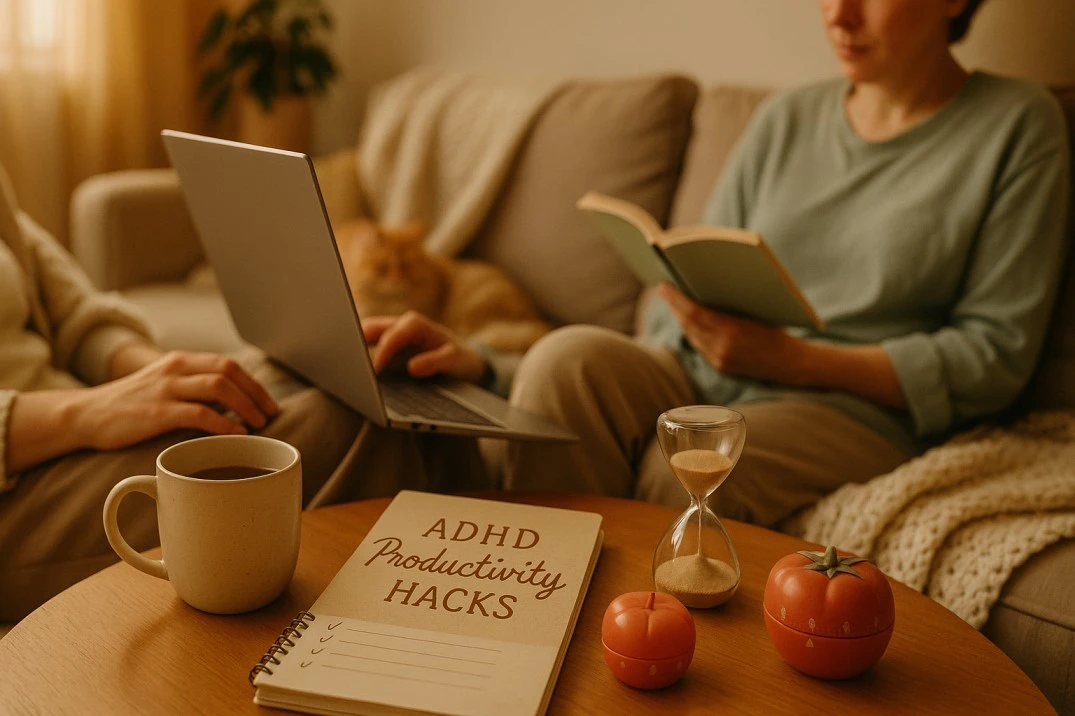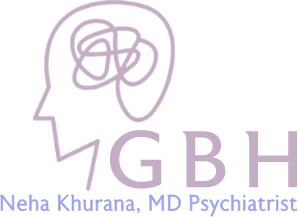
- October 13, 2025
8 ADHD Productivity Hacks That Actually Work (According to Science)
When you live with ADHD, the biggest challenge often isn’t finishing tasks, it’s starting them. The ADHD brain struggles with executive function, the mental “management system” responsible for planning, organization, task initiation, and follow-through.
This isn’t about laziness or lack of effort. It’s about how ADHD brains are wired. They thrive on novelty, urgency, connection, and reward, not the traditional structures of routine and discipline that neurotypical strategies rely on.
That’s why ADHD-friendly productivity hacks work differently. They’re not about forcing focus; they’re about creating the conditions for focus.
What Are the Best ADHD Productivity Strategies That Actually Work?
Below are 8 research-backed ADHD productivity strategies, curated by the team at Georgia Behavioral Health for ADHD Awareness Month, that can help you unlock energy, focus, and motivation, one small, practical step at a time.
1. What Is Body Doubling and Why Does It Help ADHD Focus?
✨ “Work better with someone by your side.”
Body doubling is a simple yet powerful ADHD productivity technique: doing a task in the presence of another person. That person, your “body double,” doesn’t have to help you or even work on the same thing. Their mere presence provides structure, grounding, and accountability.
One Conversation Can Change Everything! Consult Dr. Neha Khurana for expert ADHD care for children, teens, and adults.
Why It Works
- External accountability: Someone else’s presence creates gentle social pressure to stay on task.
- Co-regulation: The ADHD brain syncs with the calm focus of others, helping bypass mental resistance.
- Reduced isolation: You feel less alone when facing an overwhelming task.
- Novelty: A new social environment or connection increases dopamine and attention.
How to Try It
- Work alongside a friend or colleague in silence.
- Schedule co-working sessions via Focusmate or Flown, both offer guided virtual body doubling sessions.
- Watch “Study With Me” videos on YouTube for virtual companionship and accountability.
2. How Does the Two-Minute Rule Help With ADHD Procrastination?
🚀 “Start small, build momentum.”
ADHD brains don’t have trouble doing things; they have trouble starting them. The Two-Minute Launch Rule helps bridge that gap.
Tell yourself you’ll do a task for just two minutes. The idea is to lower the activation barrier by removing pressure to complete it. Once you begin, you’ll likely keep going.
Why It Works
The ADHD brain resists large, undefined goals. Two minutes feels achievable and activates the “momentum loop,” a dopamine-driven feedback system that rewards progress, not perfection.
Try It
- Write the first sentence of an email.
- Wash one dish.
- Open your notes app and jot one idea.
Starting is winning, because once motion begins, motivation follows.
3. Can Parkinson’s Law Actually Help You Focus Better?
⏱ “Shrink your deadline. Time pressure = focus fuel.”
Parkinson’s Law states: “Work expands to fill the time available for its completion.” For ADHD brains that crave urgency, artificially shrinking the timeline can supercharge focus.
Why It Works
- ADHD brains thrive under time pressure. The adrenaline rush activates focus and problem-solving.
- Short deadlines reduce decision paralysis by narrowing the window for overthinking.
Try It
- Set a timer for 15 minutes and see how much you can complete.
- Gamify your work: “I’ll beat the clock and finish this section before the timer buzzes.”
This turns deadlines into dopamine-fueled challenges, a perfect match for the ADHD mind.
4. How Can Task Chunking and Rewards Improve ADHD Motivation?
“Break it down + reward yourself.”
Big projects can paralyze ADHD brains. That’s where task chunking comes in, dividing a big goal into smaller, achievable pieces.
Each “chunk” ends with a quick, tangible reward: a coffee, a walk, a short scroll break. This creates frequent dopamine hits that sustain motivation.
Why It Works
ADHD brains need frequent feedback and instant gratification. Small wins, combined with built-in rewards, make large projects feel more manageable.
Try It
- Turn “clean the house” into “clean one drawer.”
- After 25 minutes of work, reward yourself with a playlist or snack.
- Stack micro-rewards, like checkmarks, stickers, or even emojis, to visualize progress.
One Conversation Can Change Everything! Consult Dr. Neha Khurana for expert ADHD care for children, teens, and adults.
5. Why Are Visual To-Do Lists More Effective for ADHD?
📝 “Out of sight = out of mind. Go visual!”
Digital lists are great, until they’re buried in tabs. ADHD brains respond better to visual, physical reminders that externalize memory and goals.
Try These Visual Systems
- Use sticky notes or whiteboards for your top priorities.
- Create color-coded task categories (urgent, creative, low energy).
- Post visual cues, such as a daily “focus board,” near your workspace.
This keeps tasks visible and tangible, helping ADHD minds transition from thinking to doing.
6. How Does Novelty Improve Focus for ADHD Brains?
🌍 “Change your scene. Novelty = motivation.”
Repetition drains ADHD motivation. Novelty, on the other hand, wakes up your attention system.
Why It Works
- New environments stimulate dopamine.
- Changing scenery re-engages the brain’s reward network.
- It reduces “task fatigue” from overused spaces.
Try It
- Work from a café, library, or outdoor space.
- Rotate your workspace setup weekly.
- Utilize sensory novelty, music, lighting, and scent to refresh your focus.
A little change can bring back a lot of mental energy.
7. How Can I Overcome ADHD Paralysis?
⚡ “Ask: What’s the first step?”
ADHD paralysis happens when your brain freezes under pressure or overwhelm. Your to-do list feels so big that your brain hits “shutdown mode.”
The key is reframing your question. Instead of “How will I finish this?”, ask “What’s the very first step?”
Why It Works
Breaking things down reduces cognitive load and helps the brain regain control. Taking one micro-step breaks the inertia, and that’s where momentum starts.
Example:
- Instead of “organize the office,” begin with “pick up one folder.”
- Instead of “finish the report,” start with “open the document.”
Small steps create motion. Motion reduces anxiety.
8. What’s the Role of Accountability in Managing ADHD?
👥 “The ADHD Buddy System: Check in, stay on track.”
External accountability helps ADHD brains thrive. Whether it’s a therapist, friend, or online partner, consistent check-ins help you follow through on goals without guilt or overwhelm.
Try It
- Find an “ADHD buddy” for weekly progress chats.
- Keep check-ins short and encouraging, not perfection-driven.
- Use shared digital boards or note apps to track goals.
Knowing someone else will follow up keeps you motivated and supported.
What Are Some ADHD Productivity Tools That Actually Help?
Here are a few evidence-based tools and resources featured in this series:
- 💻 Focusmate: Virtual co-working for built-in accountability.
- 🌿 Flown: Focus sessions and guided work blocks with real-time companionship.
- 🎧 Ambient apps: Simulate coffee shop or library sounds.
- ⏳ Pomodoro timers: Combine urgency and rest for sustainable focus.
Key Takeaways
- ADHD isn’t about laziness — it’s about energy regulation and executive function.
- Body doubling, chunking, and accountability add external structure to ADHD brains.
- Novelty, rewards, and visual cues increase dopamine and motivation.
- Small, achievable actions create long-term consistency.
- Professional support makes these strategies more sustainable.
Georgia Behavioral Health: ADHD Experts Near You
At Georgia Behavioral Health, we take a personalized, neuroscience-informed approach to ADHD and mental health care. Our team provides psychiatric evaluations, medication management, and holistic support for children, teens, and adults.
Whether you’re newly diagnosed or looking to fine-tune your strategies, we help you understand your brain — and work with it, not against it.
We’re in-network with most major insurance providers and offer virtual and in-person appointments.
People Also Ask
How can I stay motivated if I have ADHD?
Motivation for ADHD is driven by interest, urgency, and reward. Use micro-deadlines, novelty, and visible rewards to sustain momentum.
What are the easiest ADHD hacks to start today?
Try body doubling, visual lists, and the two-minute rule, all easy, no-cost, low-effort techniques that provide immediate benefits.
Why do I freeze before tasks?
This is ADHD paralysis, a response to overwhelm. Break tasks into smaller steps and ask, “What’s one thing I can do right now?”
Can these techniques replace medication or therapy?
No. These are behavioral supports that work best when combined with professional ADHD treatment, including therapy and medication management.
